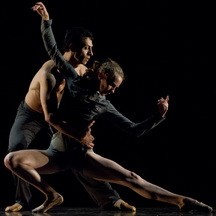
San Francisco Ballet opens the season fresh and snappy
On Sunday SF Ballet opened its 2016 season with three short pieces by three of its favorite choreographers – Helgi Tomasson, Yuri Possokhov and William Forsythe – showing a full spectrum of its technical expertise and its emotional variety.
The program opened with Tomasson’s “7 for Eight”, a beautifully lyric set of mostly duets set to Bach harpsichord concertos arranged for piano. One piece, the second movement to the “Concerto for Four Harpsichords” was reduced to one harpsichord. The music showed off not only the dancers’ prowess but also that of the SF Ballet Orchestra, which celebrates its 40th anniversary this season. Mungunchimeg Buriad was the pianist with the exquisite touch and timing.
I’m always intrigued by choreographers that choose Bach to set; ballet being so closely identified with the 19th century and American ballet being shaped so definitively in the 20th century by Balanchine and Stravinsky alongside the forces of modern dance and Hollywood. But Bach also seems a perfect composer for dance, presenting a geometric clarity and logic to notes that can only sustain the familiar demands of the dancer’s earliest and most primal training. The count is unmistakable.
What moves the music into the realm of dance on stage, rather than the classroom, is Bach’s own investigations of tempi. It seems that what the composer is reaching for is the emotional meaning of count, through a total dedication to that count. If it didn’t seem so obvious we could just say there is an emotional spin to adagio that is different from that of allegro, but Bach always reveals that it isn’t that simple. It is the emotional complexity that differs from tempo to tempo, not simply its mood.
This is where dance best steps – jetés? – in.
Tomasson is not unlike Bach, in that his choreography is his very own. It’s hard not to recognize a piece as his. His work is above all lyrical, classical leaning strongly toward neoclassical, formal and gendered. Boys leap and girls spin, but the gravity with which all that is realized makes the work appeal to our deepest romantic nostalgia. It is Balanchine without the sly intelligence. It pulls elegantly at our heartstrings.
Costumed in black – the ballerinas’ legs and shoulders providing dazzling contrasts – and lighted sparely on a blank stage, “7 for Eight” is no exception in Tomasson’s oeuvre. It is simply lovely.
Tomasson is no egomaniacal artistic director, though. He seeks out choreographers that provide serious artistic contrasts to his own predilections and that stretch the imaginations and technical skills of his very talented dancers. One of those is the company’s Choreographer in Residence Yuri Possokhov. The second piece on the program is Possokhov’s first commissioned piece “Magrittomania.” Supposedly, a manic contemplation of the French surrealist, the ballet has a distinctly Eastern European noir sensibility. It’s a mentality that showed itself again in the choreographer’s “Swimmer” – a darkly humorous look at suburban America.
Possokhov’s eastern edge is emphasized in “Magrittomania” by the music of composer Yuri Frasavin, which is a reworking of Beethoven, comic in its rephrasing. Honestly, Klezmer music side by side with Für Elise? I loved the music and the choreography, they were sublimely witty. But even with large green apples and bowler hats the work remained outside Magritte and French surrealism, and therefore puzzling to me.
What I would really like to see is the sensibility come home. Would Possokhov and Krasavin consider doing Bulgakov? I am ready for a ballet version of “The Master and Margarita.” Who, I am anxious to know, will dance Behemoth, the Black Cat, sipping his vodka?
The last piece on the program was William Forsythe’s incandescent “Pas/Parts.” Set to composer Thom Willems’ electronic music, and staged within a set of white walls, like a large cool box, the piece is another of Forsythe’s impossibly demanding and virtuosic pieces. The company seems to love the challenge, and they rise to the twisting rhythms and surprising shifts of the choreography.
“Pas/Parts” was originally choreographed for the Paris Opera Ballet, but was reworked on the San Francisco Ballet for this North American premiere. Over three-quarters of the 37-minute ballet have been reconfigured with the company.
This was a warm and generous program, showing the best the company achieves in contemporary choreography. And now is the time to see it, when the company can give its all.
– Jaime Robles
SF Ballet’s Program 1 continues through February 5. Program 2 opens January 27. For more information and tickets, visit www.sfballet.org.
Photo: Yuan Yuan Tan in Yuri Possokhov’s “Magrittomania”. Photo by Erik Tomasson.
